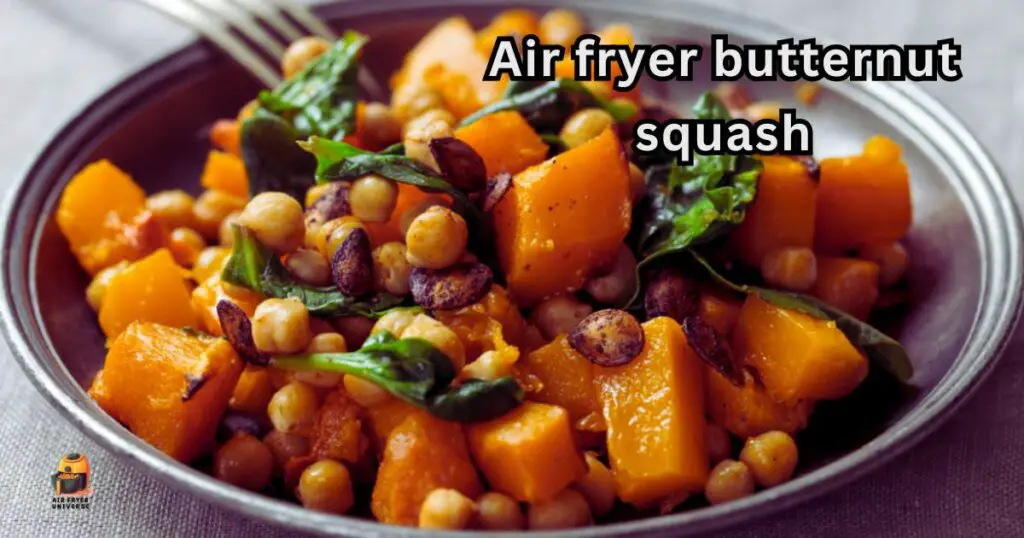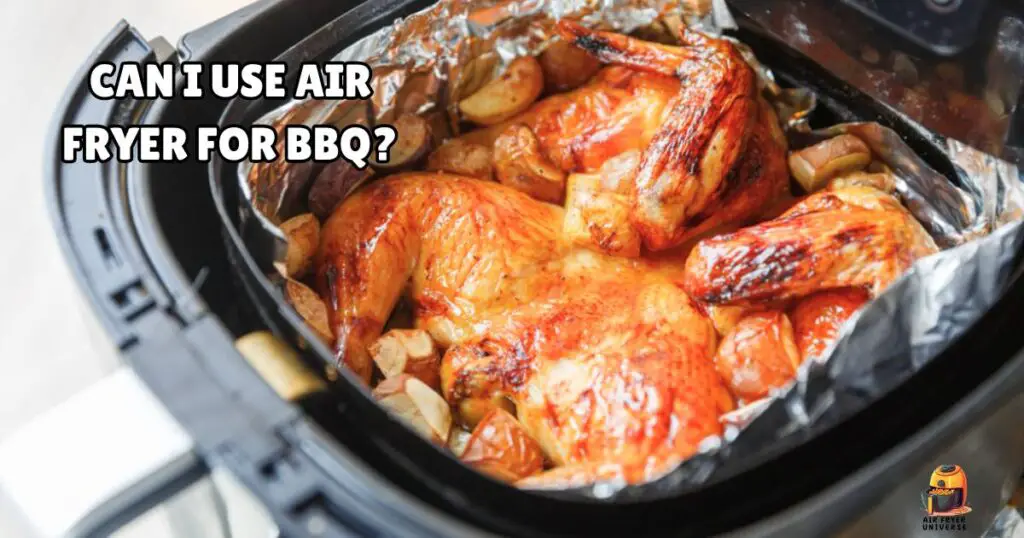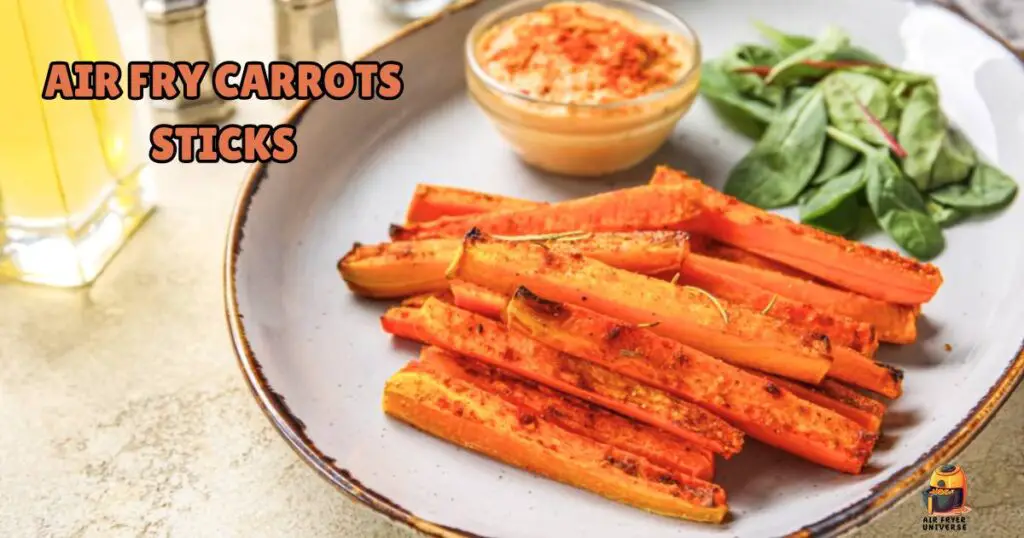Table Of Contents
Air fryer butternut squash is a delightful and healthy side dish that’s easy to prepare. Begin by peeling, seeding, and cutting the squash into your preferred shape. Toss the pieces in olive oil, season with herbs and spices, and air fry until tender and slightly crispy.
The air fryer’s quick and even cooking ensures that your butternut squash turns out perfectly caramelized and flavorful. Enjoy it as a side with roasted meats or in various recipes like soups, salads, and grain bowls. Air frying butternut squash is a convenient way to savor this nutritious vegetable all year round.

Benefits of Butternut Squash
Butternut squash, a popular winter squash variety, offers a range of health benefits:
Nutrient-Rich Profile
Butternut squash is a nutritional powerhouse. It is an excellent source of essential vitamins and minerals, including vitamin A, vitamin C, vitamin E, vitamin B6, potassium, manganese, and folate. These nutrients provide crucial functions in general wellness.
Antioxidant Content
Butternut squash is rich in antioxidants, particularly beta-carotene, which gives it its vibrant orange color. Beta-carotene is converted into vitamin A in the body and is known for its powerful antioxidant properties. Antioxidants help combat oxidative stress, reducing the risk of chronic diseases and supporting healthy aging.
Eye Health
The high levels of vitamin A in butternut squash are crucial for maintaining good vision. Vitamin A plays a significant role in the health of the retina and may help prevent conditions like night blindness and age-related macular degeneration.
Immune System Support
Vitamin C, another essential nutrient found in butternut squash, is well-known for its immune-boosting properties. It aids in the production of white blood cells and antibodies, helping the body defend against infections.
Heart Health
Potassium, a mineral present in butternut squash, helps regulate blood pressure. Consuming potassium-rich foods may lower the risk of hypertension and reduce the strain on the cardiovascular system.
Weight Management
Butternut squash is low in calories and high in fiber, making it an excellent choice for those looking to manage their weight. The fiber promotes a feeling of fullness, reducing overall calorie intake.
Digestive Health
The fiber content in butternut squash aids in digestion by preventing constipation and promoting regular bowel movements. A healthy digestive system is critical for overall health.
Blood Sugar Control
The fiber in butternut squash, along with its low glycemic index, can help stabilize blood sugar levels. This is especially important for people who have diabetes or are at risk of developing it.
Skin Health
The vitamins and antioxidants in butternut squash contribute to healthy skin. Vitamin C, in particular, supports collagen production, reducing the signs of aging and protecting against UV damage.
Anti-Inflammatory Properties
Some compounds in butternut squash, such as beta-cryptoxanthin and quercetin, have anti-inflammatory properties that may help reduce inflammation in the body, potentially benefiting conditions like arthritis.
Bone Health
Butternut squash contains essential minerals like calcium and magnesium, which are crucial for maintaining strong and healthy bones. These minerals are vital for bone density and may help prevent conditions like osteoporosis.
Pregnancy Nutrition
Folate, present in butternut squash, is a critical nutrient for pregnant women as it supports the baby’s neural tube development, reducing the risk of birth defects.
Incorporating butternut squash into your diet offers a wide array of health benefits, making it a valuable addition to your meals. Whether roasted, steamed, mashed, or added to soups and stews, this versatile vegetable can be enjoyed in numerous delicious and nutritious ways.
How to Make Air Fryer Butternut Squash
Air frying butternut squash is a simple and delicious way to enjoy this nutritious vegetable. Here’s a step-by-step guide to making air fryer butternut squash:
- 1 butternut squash
- Olive oil or cooking spray
- Salt and pepper to taste
- Optional seasonings (such as cinnamon, paprika, or rosemary)
- Choose a butternut squash that feels heavy for its size, with firm skin free from blemishes or soft spots. This indicates freshness.
- To begin, thoroughly wash the squash under running water.
- Using a sharp knife, cut off both ends of the squash to create flat surfaces. This makes peeling and cutting easier.
- Use a vegetable peeler to remove the tough outer skin of the squash. Ensure you remove all the green or white parts.
- Once peeled, cut the squash in half vertically to expose the seed-filled cavity.
- Use a spoon to scoop out the seeds and any stringy pulp from the center of each squash half. If you’d like, you can reserve the seeds for roasting.
- Make a decision regarding the butternut squash preparation. You can dice it or slice it into thin rounds. The choice depends on your preference and the dish you plan to make.
- Place the sliced or diced squash in a large bowl.
- Drizzle with olive oil or use a cooking spray to coat the pieces evenly. This oil helps the squash become crispy during air frying.
- Season with salt and pepper to taste. You can also add other seasonings like paprika for a smoky flavor, cinnamon for sweetness, or herbs like rosemary or thyme for extra aroma and taste.
- Preheat your air fryer to 380°F (190°C). Preheating promotes crispiness and guarantees even cooking.
- Arrange the seasoned butternut squash pieces in a single layer in the air fryer basket. Avoid crowding; if necessary, cook in batches.
- Cook for approximately 12 to 15 minutes, flipping or shaking the basket halfway through. Cooking times can vary based on the size and thickness of your squash pieces. The goal is tender, lightly browned squash.
- Once the squash reaches your desired level of crispiness and tenderness, carefully remove it from the air fryer.
- Serve hot as a side dish or mix it with other recipes. Air-fried butternut squash pairs well with salads, soups, pasta dishes, grain bowls, and more.
Read More:
How to Use Butternut Squash
Butternut squash is a versatile and nutritious ingredient that can be used in a variety of ways in your cooking. Here are some popular methods for using butternut squash:
Roasting
To roast butternut squash, first peel it with a vegetable peeler. Cut it in half, scoop out the seeds, and then dice it into even-sized pieces. Toss the cubes with olive oil, salt, pepper, and any desired seasonings. Spread them in a single layer on a baking sheet and roast in a preheated oven at 400°F (200°C) for about 25-30 minutes or until they are tender and caramelized.
Soup
For butternut squash soup, start by peeling and dicing the squash. Sauté onions and garlic in a large pot, add the diced squash and cover with vegetable or chicken broth. Simmer until the squash is soft, then puree the mixture until smooth. Season with spices like nutmeg, cinnamon, salt, and pepper to taste. You can also add cream or coconut milk for creaminess.
Mashed
Steam or boil peeled and cubed butternut squash until it’s fork-tender, usually in about 15-20 minutes. Drain and mash it with butter, salt, and a bit of cream or milk until you achieve your desired consistency. Season with salt and pepper to taste.
Pasta Sauce
After roasting or steaming the squash, puree it and mix it with your favorite pasta sauce. Heat the sauce gently and serve it over cooked pasta for a creamy and nutritious pasta dish.
Salads
Roasted or steamed butternut squash can be added to salads for a hearty and sweet element. Consider pairing it with spinach, arugula, toasted nuts, goat cheese, and a balsamic vinaigrette.
Stir-Fry
Cut butternut squash into thin strips or small cubes and stir-fry it with other vegetables like bell peppers, broccoli, and snap peas. You can add tofu, chicken, or shrimp for protein. Flavor with your choice of stir-fry sauce.
Risotto
Incorporate diced butternut squash into your risotto. Sauté it with onions and garlic before adding Arborio rice. Gradually stir in warm broth and cook until the rice is creamy. Finish with Parmesan cheese and seasonings.
Tacos or Burritos
Roasted butternut squash can be a tasty and healthy filling for tacos or burritos. Combine it with black beans, salsa, avocado slices, and your favorite toppings.
Side Dish
To serve butternut squash as a side dish, steam or boil it until tender, which takes about 15-20 minutes. Season it with a drizzle of olive oil, salt, and perhaps a sprinkle of fresh herbs like rosemary or thyme.
Baking
Butternut squash puree can be used in baking to add moisture and a hint of sweetness. Incorporate it into muffin, bread, or cake recipes as a nutritious twist.
What to Look for When Picking a Butternut Squash
When selecting a butternut squash, keep an eye out for these key factors to ensure you pick a ripe and flavorful one:
- Firmness: A ripe butternut squash should feel firm and sturdy when you press it with your fingers. Avoid squash that has soft spots, as this can indicate overripeness or spoilage.
- Color: Look for a butternut squash with a uniform, beige-tan color. While some minor variations in color are natural, avoid squash with green or yellow patches, as this could signify underripeness.
- Skin Texture: Check the skin for any cuts, bruises, or blemishes. While small imperfections are generally acceptable, choose squash with smooth and unblemished skin. A few scars or scratches won’t affect the quality.
- Weight: For its size, a decent butternut squash ought to feel substantial. This indicates that it has a higher water content and will likely be less dry when cooked.
- Stem: Check that the stem at the top of the squash is intact and firmly attached. A missing or loose stem can be a sign of mishandling or age.
- Neck-to-Bulb Ratio: Consider the proportion of the neck (the narrower, top part) to the bulb (the wider, bottom part). Squash with a longer neck tends to have more flesh and less seed cavity, making it a better choice for cooking.
- No Soft Spots: Gently press your fingers over the entire surface of the squash to ensure there are no soft spots. Soft spots can indicate decay or spoilage.
- Size: Choose a size that suits your recipe needs. Butternut squashes come in various sizes, from small to large. Select one that aligns with your cooking plans.
- Season: While butternut squash is typically harvested in the fall and is at its peak freshness during that time, it’s available year-round in most grocery stores. If purchasing out of season, be especially vigilant in assessing its quality.
- Avoid Pre-cut Squash: Although pre-cut butternut squash can save you time, it’s often better to choose a whole squash. Pre-cut varieties may have a shorter shelf life and could be less fresh.
FAQs
Do I Need to Peel Butternut Squash Before Roasting?
Yes, you need to peel butternut squash before roasting. The skin can become tough and doesn’t soften like the flesh. Peeling ensures a more pleasant texture and allows seasonings to infuse the squash effectively.
How Long Does Butternut Squash Take to Get Soft
The time it takes for butternut squash to become soft depends on the cooking method. When roasting in an oven at 400°F (200°C), it usually takes around 30-45 minutes. When boiling, it softens in about 15-20 minutes, and in a microwave, it can take 10-15 minutes, depending on the size of the pieces.
Is Butternut Squash Keto Friendly?
Yes, butternut squash keto keto-friendly. This is because butternut squash has so many net carbs that if you eat too much of it, you may consume too many carbs. Limit your serving sizes while eating butternut squash on keto.
Final Verdict
Air fryer butternut squash is a fantastic way to enjoy this nutritious vegetable with minimal effort. It offers a crisp exterior and tender interior, making it a delightful side dish or addition to various recipes.
The air fryer’s speed and efficiency mean you can have perfectly cooked butternut squash in no time. With some seasoning and creativity, it becomes a versatile ingredient that complements both savory and sweet dishes.
Whether you’re following a specific diet or simply looking for a tasty and hassle-free cooking method, air fryer butternut squash is a win-win for its convenience and flavor.
You May Also Like to Read:







